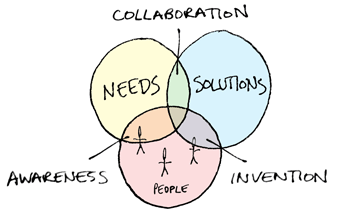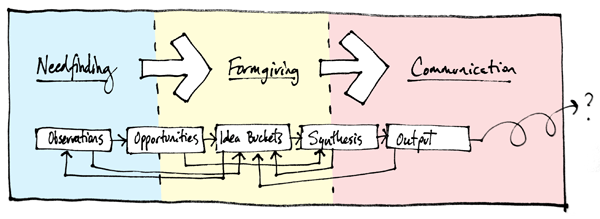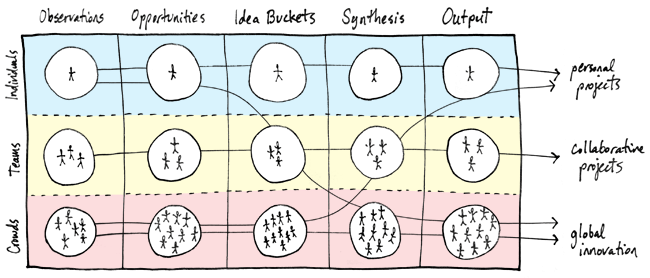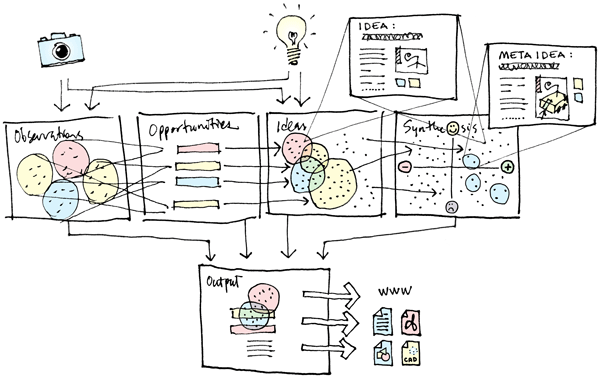  |
Welcome to AmbiThink
Innovation is driven by human creativity: the often spontaneous and egoless process of expression and learning through which individuals invent solutions to their immediate problems. Governments and corporations invest billions in innovation to stay ahead of the pack, outsourcing innovation to designers and strategic consultants. These very innovation experts, however, know that sharing ideas is the best way to improve them and that closed innovation efforts are often at odds with the wider social potential of human-centered design. Ambithink seeks to make the basic tools of the innovation industry transparent by putting them in the hands of the online community for free.
Applying design strategy to solving problems, as in engineering projects or other creative processes, requires that the designer be attuned to the subtleties of human behavior and have synthesis skills by which to discern cultural trends, pain-points, blocks, and opportunities. Once identified, this information can provide a valuable roadmap for the accomplishment of project goals. Ambithink introduces this process creative people anywhere in a simple and intuitive way, to help them develop their most useful ideas. It also encourages the sharing of ideas, either in groups or with the internet community at large. By helping the most useful and open ideas to become realized, Ambithink is dedicated to the improvement of human life through design.

General Workflow
Ambithink is the "Flickr" for creative ideas; it's the place you go when you experience the flash of the muse. At its most basic level it is a free online idea synthesis platform, allowing observations and ideas in all forms (descriptions, images, audioclips, tags, etc.) to be uploaded, stored, and made sense of over time. The interface will be designed to leverage extremely non-linear connections between thoughts, resembling clouds of visual data that can be dragged, clustered and grouped with guidance by the system. Every time you have a half-baked idea that you think might be useful, Ambithink is the open-source oven that helps make it reality.
Design can be considered a three step process consisting of identifying needs, giving form to possible solutions, and communicating these solutions to others. The first phase, also called "needfinding," deals with uncovering opportunities for potential innovation. This process entails ethnographic research, qualitative synthesis, and a focus on human factors. The central phase, also called "formgiving," is where ideas are elaborated and bounced around, through brainstorms, sketching sessions, and idea synthesis. The final phase always involves communication, even if only as part of the creative process. During the communication phase designers explain their ideas to themselves, to the public, or to whoever may be implementing the final design.
The Ambithink system is designed to support this general workflow. Because idea generation happens all the time, not just during structured moments, the interface allows new ideas to be added anywhere at any time, even on the go. Five main "task-modules" have been identified to simplify the idea development process. These modules (which are also shown as tabs in the navigation bar above) include: Observations, Opportunities, Idea Buckets, Synthesis, and Output.
Collectively these modules guide users from needfinding to communication, although the sequence between modules need not necessarily be linear (the "Synthesis" module can be used to organize opportunities, for example, and often "Idea Buckets" lead to new observations). Ultimately users can sort and organize their ideas whenever and however they please and, as new modules are developed by the internet community over time, they can be plugged into the workflow to improve the usability of the system.

An in-depth look at each of the task-modules can be found by examining the following pages. At this point it suffices to say that different configurations of modules may be useful for different users or projects. Many users may only be interested in "Idea Buckets," for example, since they are interested in contributing ideas to projects that are already in progress. Strategic thinkers and blue-sky innovators, on the other hand, may find utility in organizing their observations into design opportunities. The output module, containing simple tools for viewing, exporting and sharing the results of the design process, allows users to output text documents or more deeply refined process reports, or publish directly to blogs or other easily distributed formats.
Levels of Sharing
Experienced innovators know the importance of sharing, not hoarding, their best ideas. In this spirit, Ambithink seeks to leverage collaborative innovation. The personal benefits provided by an open-source innovation system will radically outweigh an individual's reluctance to share. This may seem contrary to common sense, but it is implicit in the logic of open-source thinking.
Highly competitive environments stifle creativity. When individuals are rewarded when they are "right" and punished when "wrong" it creates an environment in which generating good ideas is usually not worth the associated risks. Innovative environments must do the exact opposite: make it safe to be risky and risky to be safe. Discussing his approach to teaching design thinking at Stanford, for example, Professor Rolf Faste has written the following:
Creative engineering requires being open with others... Competition is over rated as a motivator. Too often it leads to egocentric, non sharing behavior and even cheating. Sufficient competition exists in the sense of competing against yourself—that is, trying to do one's personal best. For this reason, none of my assigned projects requires or encourages students to compete with each other. Quite the reverse, students and student teams are asked to pin up all their ideas on the wall every class and share them with the whole world. In the spirit of T.S. Elliott's dictum, "Good poets copy, great poets steal," students are encouraged to incorporate and improve on any idea on the wall, whether it is theirs or not.
At first, students rebel at the thought of sharing their great initial ideas with others. With reluctance they begin to see that what they thought was a great idea was also thought of by three other groups, or that other groups had better ideas, or that their idea combined with another's would make a really good idea. At presentation time it becomes clear that the whole class "wins" when each team shows an outstanding solution [1].
Inspired by this model of open-source thinking, the Ambithink system incorporates levels of sharing. It encourages users to be as open as possible within each task-module, but allows for three levels of idea privacy (personal, collaborative, and global). Sharing ideas is highly encouraged, but personal privacy is also protected (see below).
Imagine for example that a user is working on a project. In its simplest implementation, Ambithink provides personal repositories of ideas online, and visual organization tools within each task-module. An early release could be limited to this personal level, and the outcome would be exclusively personal projects. This level is essential to the innovation of the Ambithink system at large because it provides individuals a "safe space" within which to create. At each stage of the process, however, the system will educate users to the benefits of sharing their ideas with others, such as brainstorming together with members of a team. Collaborative projects allow feedback on ideas-in-progress and drive projects towards tangible implementation.
Two simple buttons, "Get Feedback" (make it one-level more public) and "Work With This" (make it mine) would allow an easy interface between "private" and "public" ideas at each stage of development. If one user chooses to work with someone else's idea, for instance, the originator could be notified and both parties could be encouraged to collaborate on a project or team. In this way, even ideas that are kept highly personal would migrate into and out of the public domain.

The "global" level provides the most innovative aspect of the Ambithink system. This level provides visibility to individual inventors, and "calls-to-action" for problems that need innovative solutions. If, for example, the "global" Opportunities view indicates that suntan lotion is destroying the world's coral reefs, individuals or teams could develop "private" solutions to solving this problem. On the flipside, a mother who's frustrated with the folding mechanism of her child's car seat could snap a photo of how she solved the problem using a bungee-cord, or post an opportunity saying "someone please fix this." In this way Ambithink effectively becomes a globalized "Wiki-sensor" of design process knowledge, fostering innovation in response to the people who need it. Of course, the global level also has the potential to distribute and manage chaos instead of useful innovation.
One of the principal aims of the system at this level, therefore, will be to guide the community to curate a useful "overview portal" that is useful and relevant to the multitude of system users.
Open Innovation vs. Intellectual Property
The collaborative nature of Ambithink raises numerous questions regarding idea ownership. Unlike innovation in a corporate silo, where developed ideas belong to corporations, Ambithink generated ideas belong directly to the people who develop them. But how does this work from an intellectual property standpoint? Especially in shared situations, who profits?
Basically the Ambithink philosophy is this: anyone is free to use whatever ideas they want (all information is part of a "creative commons"), but access to those ideas is carefully protected. Protection is so strong, indeed, that the only person in your "commons" could be yourself. Ambithink provides two kinds of protection; let's call them "hard" protection and "soft" protection. Hard protection has to do with encryption (keeping information safe from hackers). Soft protection has to do with visibility (if people can't see you, they won't know you exist).
Hard protection is relatively straightforward; millions of people worldwide share confidential information over the internet using services like Google and Yahoo! mail, even large corporations who should probably know better. Yes, security is always an issue; Google and Yahoo! do their best to keep your information safe, but they also make you sign a legal agreement when you set up your account that protects them from liability. It also lets them update their terms of use whenever they want to, so what you signed last year might not be what the terms are now. In any case, you trust them to keep your information safe, and that's what they do. Ambithink is similar, in that each user has a protected account. But the terms of service are much more clear. Unlike Google, nobody from "within" the organization will troll through your data to push you ads. Ambithink is nonprofit. There are no ads.
Nobody "within" the organization can profit from your data; that would be a federal crime.
When a user signs up for an Ambithink account, they agree that their ideas will be distributed under a "creative commons" agreement. "Creative commons" is not synonymous with zero-profit, or zero-ownership. This is where soft protection comes into play. Like many social networking sites, Ambithink provides levels of protection. Some only viewable by yourself, like your account password (or in our case your unshared ideas), while other information is only viewable by friends, or friends of friends, etc. Within these well protected boundaries, however, information safety is largely in your own hands. If you send an email to someone you don't trust, they could forward it on to many other people. If you broadcast your status, everyone can see it. A well designed interface paradigm clarifies these rules; it makes it evident if your content is visible and to whom.
Now the interesting thing about idea development is that what you do with your content determines how successful it will be. Yes, like email, if you share an idea someone might steal it. But first they would need to see it, and then they would need to care about it. A lot of email sits around on servers forever, and there are a lot of potentially "bad" ideas. Open innovation essentially has to do with managing risks [2]. And taking risks is central to creative activity [3].
Ambithink therefore seeks to create an environment where it is safe to take risks, and risky to be safe. If you don't share anything, everything is safe. And if everything is safe, it isn't creative. Ambithink will leverage lots of best practices from the innovation industry to encourage generation and sharing of risky ideas. If all you share is garbage, it's "garbage out, garbage in." But one person's garbage might be someone else's bright idea.
Many of the first users of Ambithink would be small independent designers. The system would help these people perform research and develop and share their ideas, especially across different cultures and areas of interest. For applications like low-cost product development and green energy use, this would provide a powerful network of access to related knowledge, including research papers, projects, patents, etc. It would also attract hobbyists, who would contribute engineering and design skills for free, because it helps the world and because itís fun. Like all those 3D modelers out there building models for Google Earth, Ambithink would provide an open-source repository of design thinking in action.
In summary, Ambithink proposes that a responsibly designed nonprofit innovation system will yield responsible results that help everyone profit. There are plenty of ways to make money distributing "open" material. Ambithink will do its best to give credit to everyone involved, and there are lots of ways to benefit by using the system. In our view the best profits are the ones that are open, but ultimately you can decide that for yourself; it's your system. There's a network of collaborators waiting to help you.
A Scenario
Bob, in Louisville KY, has an idea for a kitchen kettle-corn popper appliance. He gets ideas like this often, so he needs a way to keep track of them all. He goes to ambithink.org and creates an "idea note." He'd love to see this thing get made, so he clicks the "share this with my network" button.
Sophia Yin, an Industrial Design student at RISD, needs a project idea for a design sketching class so she goes on to Ambithink to look at some kitchen ideas. She sees Bob's idea, and other ideas and comments posted by other users in response, and thinks it has promise for an exciting design. She sketches lots of possible solutions for her class. She also snaps pictures of them with her iPhone, and uploads them directly to her Ambithink profile from there.
Victor von Neumann, a German engineer who was recently laid off from Airbus, sees Sophia's sketches and thinks they're great. He starts to do some engineering work on the concept, to build up his resume and improve his portfolio. He has a solid network of friends; soon many other designers have contributed their thoughts and ideas, and everyone has voted on their favorite concept. Victor uses the most popular design as the basis for a CAD model. This design would be constructed entirely out of sustainable materials from Venezuela and be easily disassembled by a recycling plant.
John, a lowly executive at Orville Redenbacher Popcorn Inc., wants a promotion. He prides himself on being in-the-know, especially when it comes to the popcorn industry. He comes across the idea on Ambithink and pitches it to his boss. They decide to make it, and soon the machine is available everywhere.
All of the parties involved in this process have profited from their participation. Sophia is happy because she can put the design in her portfolio and win a design award. Victor gets a job at Braun for his innovative engineering. John gets promoted to Regional Popcorn Director, and Venezuela is less dependant on its oil reserves. Bob buys the popper and watches movies on his plasma TV. Did we mention Bob's open-source on-demand entertainment service? Or that his television is powered by methane fuel? Cindy, in Cyprus, had those ideas last year. Now she's micro-financing farmers in Malawi.
Making it Real
The development of a fully functional Ambithink release would require significant additional human factors research, design development, and programming time. Rather than the overly prescriptive list-oriented interface presented on the following pages, flexible workflows would be developed through phases of additional observations, concept generation, scenario storyboarding, and system prototyping. A robust beta-version would then be programmed by a core development team. Significant work would be required to keep the system clean, secure, dynamic and useful. The entire project would be carefully structured so that visual elements and containers are easily "draggable" in intuitive ways, and so that the framework could be expanded by open-source programmers interested in integrating new tabs, online widgets, analytics, etc.
In the meantime, the following pages, programmed in Php, MySQL, and Flash, show an editable dataset drawn from my PhD dissertation on Perceptual Robotics. I used this primitive version of the Ambithink system to develop what I am calling "The Ultimate Aesthetic Experience," a high-impact virtual reality environment that can be experienced immersively via relatively low-cost interface technologies including stereoscopic projection, audio speakers, tactile feedback and optical tracking [4]. My intent was to leave the specific configuration and behavior of elements of the system intentionally ambiguous such that they could emerge through the process of designing and interacting with it. In this way I could explore the possible behaviors of and relations to this technological platform while maximizing its aesthetic and emotional potential.
The nonlinear process of the Ambithink system was indispensable for the collection of large quantities of data for this project, and assisted greatly in the refining of favorite ideas. Because I was focused on my robotics research, however, a majority of the envisioned system has not yet been prototyped or programmed live. The current system does not enable idea sharing, for example (all ideas are visible to all users, always, and anyone who logs in can modify these ideas). Likewise, usability is limited to simple html input forms, and dozens of potential features will require detailed design. Fortunately, if you have an idea about how to improve the Ambithink system, the system itself is at hand to record your ideas...

Questions?
Ambithink is a pilot initiative of the Rolf A. Faste Foundation for Design Creativity in collaboration with the Human-Computer Interaction Institute at Carnegie Mellon University. It was initially developed as part of Haakon Faste's PhD dissertation at the PERCRO Perceptual Robotics Laboratory at the Sant'Anna School of Advanced Studies in Pisa, Italy. Click here to send us your comments, questions or thoughts. We'd love to hear from you!
References
1. Rolf A. Faste, "Ambidextrous Thinking," Innovations in Mechanical Engineering Curricula for the 1990s, American Society of Mechanical Engineers, New York, November 1994
2. Kevin J. Boudreau and Karim R. Lakhani, "How to Manage Outside Innovation," MIT Sloan Management Review, July 1, 2009
3. Rolf A. Faste, Zengineering: A Philosophy of Design, 2003
4. Haakon Faste and Massimo Bergamasco, "Towards the Ultimate Aesthetic Experience," Proc. ACM Creativity & Cognition, 2009

|




